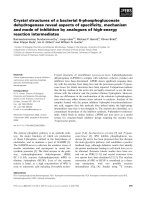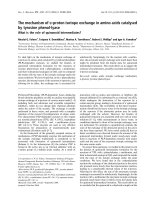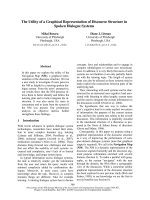báo cáo khoa học: " Granulomatous infiltration of a parathyroid adenoma presenting as primary hyperparathyroidism in a woman: a case report" ppt
Bạn đang xem bản rút gọn của tài liệu. Xem và tải ngay bản đầy đủ của tài liệu tại đây (2.23 MB, 4 trang )
CASE REPO R T Open Access
Granulomatous infiltration of a parathyroid adenoma
presenting as primary hyperparathyroidism in a
woman: a case report
İnan Anaforoğlu
1*
,Çiğdem Şiviloğlu
2
, Ayten Livaoğlu
2
, Ekrem Algün
1
Abstract
Introduction: Hypercalcemia can be associated with vitamin D (1,25(OH)
2
D
3
) -mediated granulomatous disorders
in addition to primary hyperparathyroidism (PHPT). Although most patients with granulomatous disease-related
hypercalcemia are asymptomatic, symptoms and signs of chronic hypercalcemia can occur. There are many reports
about co-presentation of a parathyroid adenoma and a granulomatous disorder in the literature. However,
granulomatous inflammation within a parathyroid adenoma is very rare.
Case presentation: A 50-year-old Caucasian woman presented with generalized bone pain and muscular
weakness. Biochemical findings suggested PHPT. She underwent excision of an enlarged right inferior parathyroid
gland. Histopathological analysis revealed features of a parathyroid adenoma with foci of epithelioid non-caseating
granulomas. The etiology of the granulomatous infiltration could not be determined. She is still normocalcemic at
the ninth month after surgery and is being followed for the possible manifestation of an occult disease.
Conclusion: Granulomatous infiltration of a parathyroid adenoma is a rare condition. Pathological examination of
the excised adenoma is the only way to diagnose the underlying occult granulomatous disorder. Clinicians should
also consider persistent hypercalcemia to be a possible indicator of concomitant parathyroid adenoma.
Introduction
Accelerated bone resorption, excessive gastrointestinal
absorption of calcium, or decreased renal excretion of
calcium can all result in hypercalcemia individually. In
some disorders, however, more than one mechanism
may be involved. Primary hyperparathyro idism (PHPT)
is the most common cause of hypercalcemia among out-
patients, whereas malignancy is the leading underlying
disorder in hospital cases . Solitary parathyroid adenoma
followed by parathyroid hyperplasia and carcinoma are
the most frequent causes of PHPT [1].
Hypercalcemia in PHPT reflects parathormone-
mediated activation of osteoclasts, leading to increased
bone resorption [1]. It has also been demonstrated to be
associated with vitamin D (1,25(OH)
2
D
3
) mediated gran-
ulomatous disorders, reflecting disordered extrarenal
production of 1,25(OH)
2
D
3
[2]. The most c ommon
granulomatous disorders causing hypercalcemia are sar-
coidosis and tuberculosis. Other non-infectious causes
include lymphoma, silicone-induced granulomatosis,
paraffin-induced granulomatosis, berylliosis, Wegener’s
granulomatosis, eosinophilic granuloma, and infantile fat
necrosis. Underlying infectious etiologies may include
candidiasis, leprosy, histoplasmosis, coccidioidomycosis,
and cat-scratch disease [2]. Although most patients with
granulomatous disease-related hypercalcemia are asymp-
tomatic, symptoms and signs of chronic hypercalcemia
can occur [2]. Herein we report a patient with PHPT
who was detected to have non-caseating granuloma s
within her parathyroid adenoma.
Case Presentation
A 50-year-old Caucasian woman presented with general-
ized bone pain and weakness. She reported a subtotal
thyroidectomy operation for her multinodular goiter
20 years before admissio n. Her medical history included
hypertension, for which she was taking amlodipine
10 mg daily, and recurrent nephrolithiasis. Her physical
* Correspondence:
1
Department of Endocrinology and Metabolism, Trabzon Numune Training
and Research Hospital, Trabzon, 61000, Turkey
Full list of author information is available at the end of the article
Anaforoğlu et al. Journal of Medical Case Reports 2010, 4:400
/>JOURNAL OF MEDICAL
CASE REPORTS
© 2010 Anaforoğ ğlu et al; lice nsee BioMed Central Ltd. This is an Open Access article distributed under the terms of the Creative
Commons Attribution License (http://creativecommon s.org/licenses /by/2.0), which permits unrestricted use, distribution, and
reproduction in any medium, provided the original work is properly cit ed.
examination was normal, and she seemed to be euthyr-
oid at presentation.
Her biochemical findings were suggestive of PHPT
(Table 1). Abdominal ultrasonography demonstrated
bilateral pelvicaliectasis and microcalculi of the right
kidney. Bone mineral density was osteopenic at her
spine and hip. Neck ultrasonography showed heteroge-
neous thyroid parenchyma and a hypoechoic lesion at
the inferior region of her right thyroid lobe compatible
with a parathyroid adenoma.
Under a presumptive diagnosis of P HPT, she under-
went excision of the enlarged right inferior parathyroid
adenoma . The excised mass was well defined with a yel-
low-pink cut surface and was measured as 20 mm ×
15 mm × 10 mm on gross examination. Histopathological
examination revealed a parathyroid adenoma with foci of
epithelioid granuloma representing non-caseating granulo-
mas (Figure 1). There were epithelioid histiocytes and
multinuclear giant cells tending to come together, with
lenfoid cells surrounding the granulomas (Figures 2
and 3). Two of her lymph nodes were compatible with
reactive hyperplasia.
Possible underlying pathophysiological disorders for
non-caseating granuloma formation were sought
thoroughly. She was completely asymptomatic for tuber-
culosis, and a polymerase chain reaction (PCR) assay for
Mycobacterium tuberculosis of the homogenates of the
parathyroid tumor was found to be negative. Quanti-
FERO N tuberculosis testing was reactive; her tuberculin
skin test was 15 mm, which was considered normal in
our country. C omputed tomographic scans of the neck
and chest did not exhibit any abnormality. To exclude
sarcoidosis, her serum angiotensin-converting enzyme
level was measured and was detected as normal. Her
fundus examination was also normal. Her medical his-
tory and clinical findings for berylliosis, coccidioidomy-
cosis, and histoplasmosis were all negative.
Nine months following the operation, the patient’ s
serum calcium level remained within the normal range
(Table 1). She is still asymptomatic and has no com-
plaint s in terms of any disease. The etiology of the non-
caseating granulomas has not been determined yet. The
patient is keen on attending regular visits, so we choose
to follow her only with watchful waiting rather than per-
form additional tests.
Discussion
Granuloma-forming major cells (macrophages) produce
extrarenal 1a(OH)ase, which may be the source of
Table 1 Laboratory Findings Before and After the Excision of the Parathyroid Adenoma
Variable Level Before Operation After Operation Normal Range
Calcium, mg/dl 11.5-12 10.1-9 8.2-11
Phosphorous, mg/dl 3.1 3.7 2.5-4.5
24-hour urinary calcium, mg/day* 340.8 60 200
Parathormone, pg/ml 105.3-98.5 40.8 15-65
25 OH vitamin D, pg/ml n.d. 34.7 10-80
1,25(OH)
2
D
3
, pg/ml 51.7 27.1 16-65
All measurements were performed in serum, except the calcium in urine (marked as *). n.d. indicates not detected.
Figure 1 Photomicrograph of hematoxylin and eosin-stained
slide preparation demonstrating the parathyroid gland and the
rim of our patient’s adenoma.
Figure 2 Photomicrograph exhibiting granulomas within our
patient’s parathyroid adenoma.
Anaforoğlu et al. Journal of Medical Case Reports 2010, 4:400
/>Page 2 of 4
inappropriately high 1,25(OH)
2
D
3
levels. Increased levels
of 1a(OH)a se can cause excessive conversion of 25(OH)
D
3
to 1,25(OH)
2
D
3
. High levels of 1,25(OH)
2
D
3
increases the absorption of calcium from the gut and
resorption of calcium from bone. This inevitably results
in hypercalcemia, decreased secretion of parathormone
by the parathyroid glands, increased filtering load of cal-
cium through t he kidneys, and hypercalciuria [2]. The
treatment consists of reducing the amount of dietary
calcium, administering low-dose glucocorticoids, and
avoiding sunlight exposure [2].
Our patient was found to harbor two disorders simul-
taneously. Her serum and urinary calcium levels were
high, which could have been considered to be consistent
with granuloma-associated hypercalcemia if she had had
a known or suspected granulomatous disease. Her pa ra-
thormone levels would be expected to be normal or
suppressed in granuloma-associated hypercalcemia;
however, this was not the case before surgery [2]. The
decrease in her serum 1,25(OH)
2
D
3
level was noted
after removal of the adenoma. Because the serum para-
thormone level decreased after surgery, related hydroxy-
lation of 25(OH)D
3
decreased as well, resulting in
reduced serum 1,25(OH)
2
D
3
levels in our patient. But
this is also inconsistent with granulomatous disease-
related hypercalcemia.
Hypercalcemia due to co-existing parathyroid ade-
noma and sarcoidosis had been published before in the
literature [3-6]; however, few cases of granulomatous
inflammation within the parathyroid adenoma had
been reported [7-9]. In these latter cases, the parathyr-
oid glands had been demonstrated to be infiltrated by
granulomatous inflammation of tuberculosis within
parathyroid adenomas. In the report from India and i n
a recent report from England, in addition to
granulomatous inflammation of the parathyroid ade-
noma, inflammation of the lymph nodes had been
detected [7,9]. Our patient showed no pathology in the
lymph nodes on either pathological examination or
imaging, although her two excised lymph nodes
showed findings consistent with reactive hyperplasia.
Kar and colleagues [7] confirmed tuberculosis wi th a
positive PCR for Mycobacterium tuberculosis,and
Sadideen and colleagues [9] showed tuberculosis by
the presence of occasional acid-fast bacilli in such
cases. As it happened in our case, Jacob et al.[8]
could not detect the origin of granulomatous inflam-
mation, and owing to the fact that tuberculosis was
common in their country, they preferred to begin anti-
tuberculous treatment for their patient. Our patient
was asymptomatic, so we decided not to administer
empirical tuberculosis treatment, even though tuberc u-
losis was also endemic in our country.
Conclusions
Granulomatous infiltration of parathyroid adenoma is a
rare condition. It is not clear whether the granuloma-
tous disease contributed to the hypercalcemia of the
present patient. Hypercalcemi a in patients who have
granulomatous disease can be managed with dietary cal-
cium restriction, avoidance of sunlight, and low-dose
glucocorticoid therapy. Even so, clinicians should keep
in mind that persistent hypercalcemia might be a sign of
concomitant parathyroid adenoma.
Consent
Written informed consent was obtained from the patient
for publication of this case report and any accompany-
ing images. A copy of the written consent is available
for review by the Editor-in-Chief of this journal.
Abbreviations
1,25(OH)2D3: Vitamin D; PCR: polymerase chain reaction; PHPT: primary
hyperparathyroidism.
Author details
1
Department of Endocrinology and Metabolism, Trabzon Numune Training
and Research Hospital, Trabzon, 61000, Turkey.
2
Department of Pathology,
Trabzon Numune Training and Research Hospital, Trabzon, 61000, Turkey.
Authors’ contributions
IA drafted the manuscript and gave approval of the final version to be
published. ÇŞ and AL substantially contributed to the acquisition and
interpretation of data. EA critically revised the manuscript. Each author
participated sufficiently in the work to take public responsibility for
appropriate portions of the content. All authors read and approved the final
manuscript.
Competing interests
The authors declare that they have no competing interests.
Received: 21 March 2010 Accepted: 9 December 2010
Published: 9 December 2010
Figure 3 Photomicrograph exhibiting granulomas within our
patient’s parathyroid adenoma.
Anaforoğlu et al. Journal of Medical Case Reports 2010, 4:400
/>Page 3 of 4
References
1. Bruder JM, Gruise TA, Mundy GR: Mineral metabolism. In Endocrinology and
Metabolism. Edited by: Felig P, Frohman LA. New York: McGraw-Hill;
2001:1079-1179.
2. Adams JS: Hypercalcemia due to granuloma-forming disorders. In Primer
on the Metabolic Bone Diseases and Disorders of Mineral Metabolism. Edited
by: Favus MJ. Philadelphia: Lippincott Williams and Wilkins; 1999:212.
3. Taguchi K, Makimoto K, Nagai S, Izumi T, Yamabe H: Cystic parathyroid
adenoma with co-existent sarcoid granulomas. Arch Otorhinolaryngol
1987, 243:392-394.
4. Robinson RG, Kerwin DM, Tsou E: Parathyroid adenoma with coexistent
sarcoid granulomas: a hypercalcemic patient. Arch Intern Med 1980,
140:1547-1548.
5. Kinochita Y, Taguchi M, Takeshita A, Miura D, Tomikawa S, Takeuchi Y:
1,25-Dihydroxyvitamin D suppresses circulating levels of parathyroid
hormone in a patient with primary hyperparathyroidism and coexistent
sarcoidosis. J Clin Endocr Me tab 2005, 90:1380-1385.
6. Bal A, Sachdeva MU, Joshi K, Behera A, Arora S, Gupta S: Non-functioning
mediastinal parathyroid adenoma with sarcoid-like granulomatous
lymphadenopathy. APMIS 2007, 115:754-758.
7. Kar DK, Agarwal G, Mehta B, Agarwal J, Gupta RK, Dhole TN, Mishra SK:
Tuberculous granulomatous inflammation associated with adenoma of
parathyroid gland manifesting as primary hyperparathyroidism. Endocr
Pathol 2001, 12:355-359.
8. Jacob PM, Sukumar GC, Nair A, Thomas S: Parathyroid adenoma with
necrotizing granulomatous inflammation presenting as primary
hyperparathyroidism. Endocr Pathol 2005, 16:157-160.
9. Sadideen HM, Blaker P, O’Donnell P, Taylor J, Goldsmith DJ: Tuberculosis
complicating tertiary hyperparathyroidism in a patient with end-stage
renal disease: a case report. J Nephrol 2008, 21:438-441.
doi:10.1186/1752-1947-4-400
Cite this article as: Anaforoğlu et al.: Granulomatous infiltration of a
parathyroid adenoma presenting as primary hyperpara thyroidism in a
woman: a case report. Journal of Medical Case Reports 2010 4:400.
Submit your next manuscript to BioMed Central
and take full advantage of:
• Convenient online submission
• Thorough peer review
• No space constraints or color figure charges
• Immediate publication on acceptance
• Inclusion in PubMed, CAS, Scopus and Google Scholar
• Research which is freely available for redistribution
Submit your manuscript at
www.biomedcentral.com/submit
Anaforoğlu et al. Journal of Medical Case Reports 2010, 4:400
/>Page 4 of 4








![Tài liệu Báo cáo khoa học: Specific targeting of a DNA-alkylating reagent to mitochondria Synthesis and characterization of [4-((11aS)-7-methoxy-1,2,3,11a-tetrahydro-5H-pyrrolo[2,1-c][1,4]benzodiazepin-5-on-8-oxy)butyl]-triphenylphosphonium iodide doc](https://media.store123doc.com/images/document/14/br/vp/medium_vpv1392870032.jpg)
